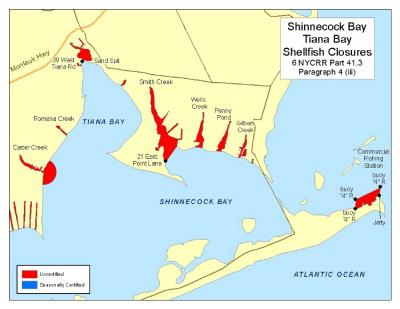State Reopens Shellfishing Areas, Warns of Blue-Green Algae in Southampton

The New York Department of Environmental Conservation reopened approximately 3,600 acres of shellfish lands in the Town of Southampton on Friday, two weeks after closing the area following the detection of saxitoxin, a marine biotoxin that causes paralytic shellfish poisoning. A prohibition on taking carnivorous gastropods — conch, whelk, and other marine snails — remains in effect.
All of Shinnecock Bay west of the southbound lanes of the Ponquogue Bridge, and all bottomlands east of the western side of the Post Lane Bridge in Quogue, were reopened on Friday. Approximately 315 acres in a cove outside the mouth of Weesuck Creek in East Quogue will closed to shellfish harvesting.
The D.E.C.'s reopening of the waterway followed extensive testing of shellfish samples from western Shinnecock Bay. The D.E.C.'s microbiology laboratory tested more than 85 shellfish samples for biotoxin since late March, with 20 of those collected from Shinnecock Bay.
Separately, the D.E.C. identified an outbreak of cyanobacteria blooms, more commonly known as blue-green algae, in Mill Pond in Water Mill, Lake Agawam in Southampton, and Lake Ronkonkoma. Health officials have asked residents not to swim or wade in the affected waters and to keep pets and children away from the area. Cyanobacteria can be harmful to humans and animals.
Blue-green algae are naturally present in lakes and streams. Warm water temperatures, and a lack of tidal flushing, can contribute to an abundance of the algae, however, which can lead to blooms in shades of green, blue-green, yellow, brown or red. Blooms may also produce floating scums on the water's surface or may cause water to take on paint-like appearance.
Exposure to cyanobacteria can cause vomiting or diarrhea; skin, eye or throat irritation; nausea, or allergic reactions or breathing difficulties. Those affected should seek medical attention.
Last summer, the East Hampton Town Trustees, who manage many of the town's beaches, waterways, and bottomlands on behalf of the public, closed Georgica Pond in East Hampton to the harvesting of shellfish, citing the appearance of cyanobacteria, or blue-green algae, which can be harmful to humans and animals. The closure remained in effect for several months.
Saxitoxin, which was found in Shinnecock Bay, affects the nervous system and paralyzes muscles. High levels of paralytic shellfish poisoning can be fatal. Carnivorous gastropods feed on shellfish and can accumulate biotoxins at levels that are hazardous to human health.
One day after the May 7 closure in Southampton, the D.E.C. took the same action in the Town of Riverhead. There, all underwater lands in Meetinghouse and Terry Creeks, covering approximately 100 acres, were closed to the harvesting of carnivorous gastropods until further notice after shellfish collected in Meetinghouse Creek tested positive for saxitoxin. The harvesting of shellfish is prohibited on a year-round basis there.
The D.E.C.'s emergency shellfish closure information line, 631-444-0480, offers a recorded message advising of the status of temporarily closed shellfish areas. The message is updated during closures. Maps of affected areas are at the agency's website, dec.ny.gov.
